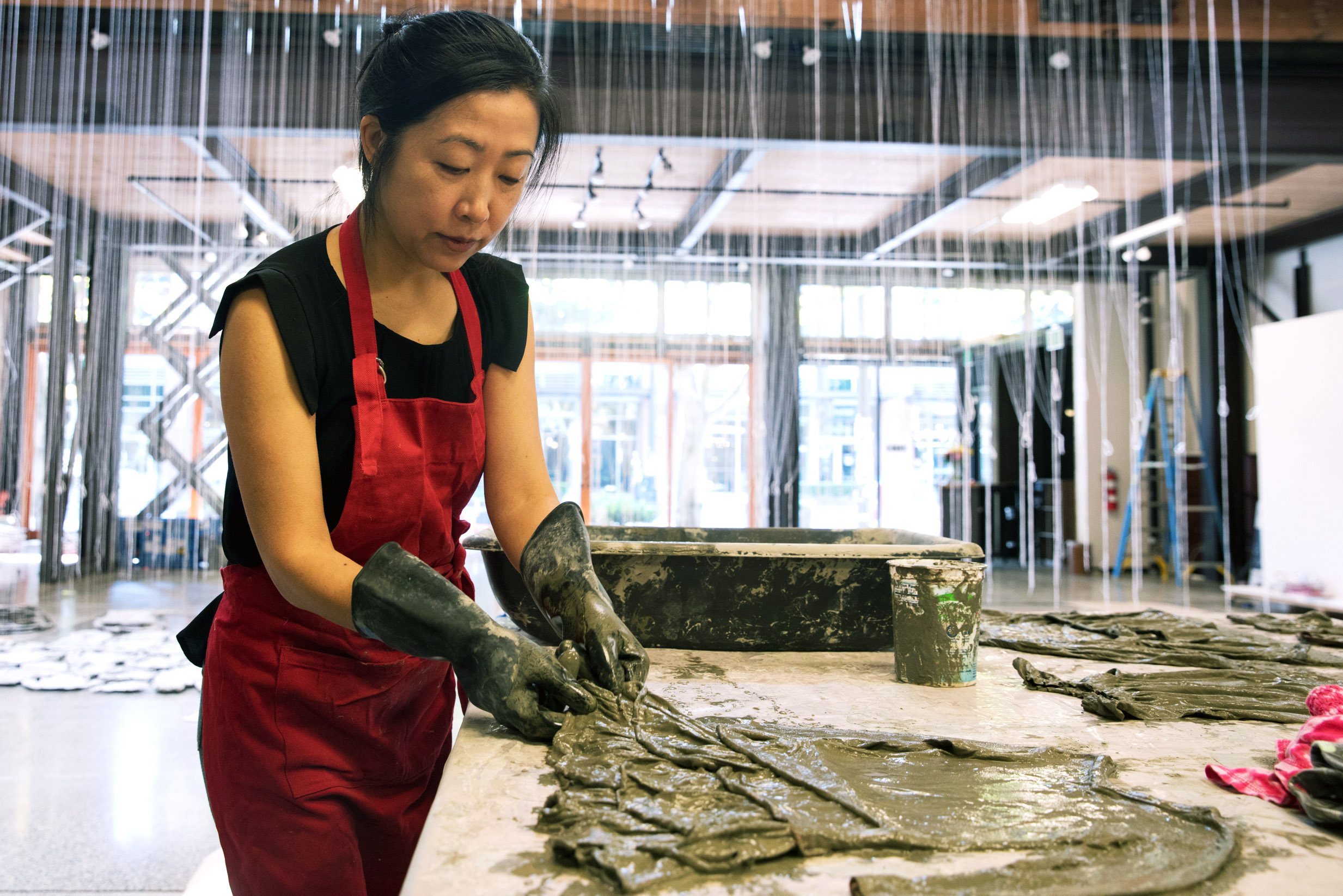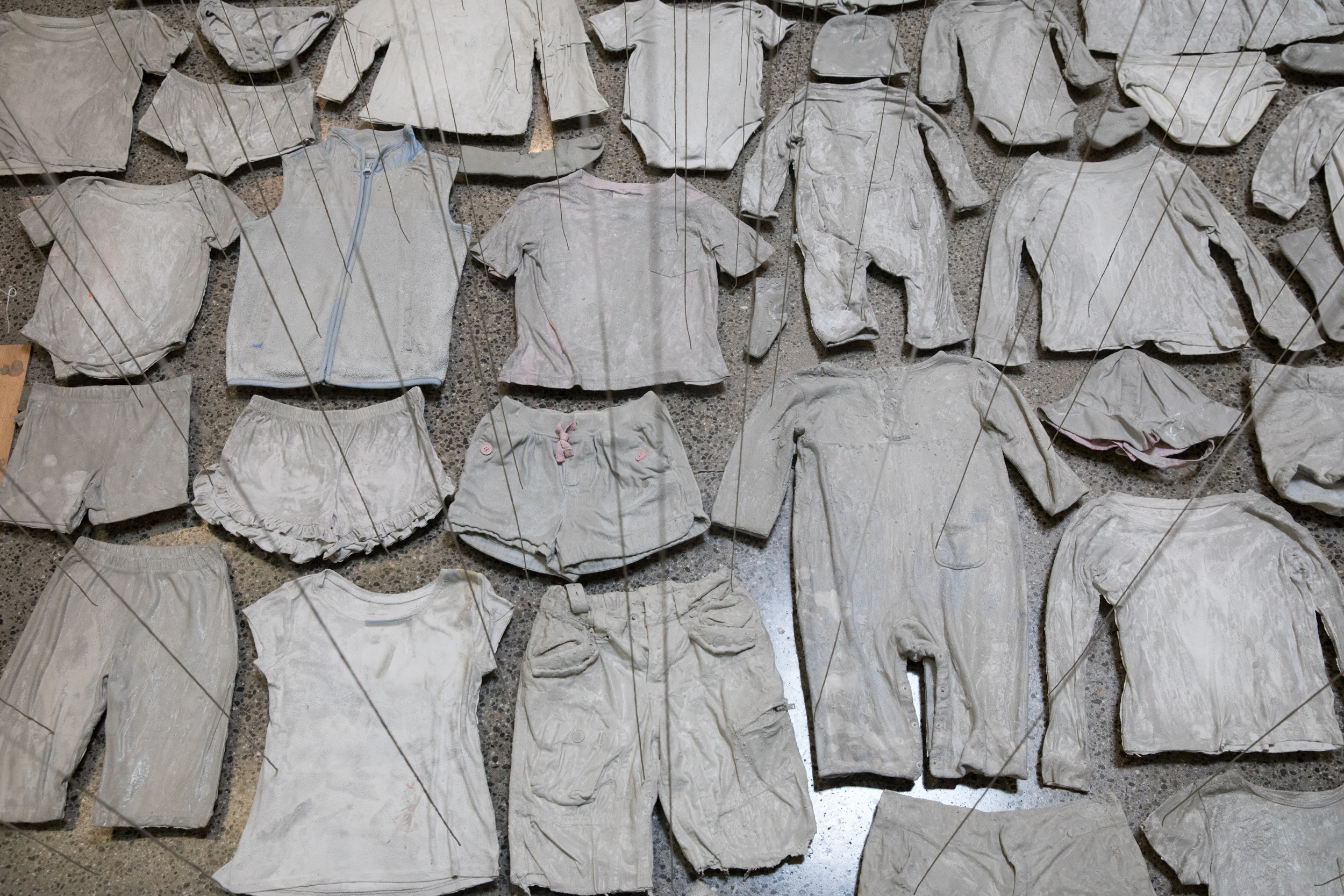As they pass by MadArt Studio, the large-windowed, former auto showroom on Westlake Avenue, a few of them glance inside to see a curious sight: a woman laying out children’s clothing that has been solidified in cement. She works slowly, carefully covering the polished terrazzo floor with little ruffled dresses, kid pants, onesies and underwear — all turned stiff and gray and flat. In stark contrast to the buzzing activity outside, the overwhelming sense is stillness.
With her new installation Each and Every, Austin-based artist Beili Liu is calling attention to another group of kids — the thousands trapped in the mire of the immigration crisis at the southern border of the U.S. Just as those children have been detained indefinitely, so are these garments frozen in place.
“I had the idea for working with clothing two or three years ago,” Liu says. At that point she was thinking about how to address the global refugee crisis. “But the piece expanded last year,” she says, “when they started separating children from their parents at the detention centers.”
A first-generation immigrant herself, Liu came to the U.S. 24 years ago to pursue her education. “Much of my work speaks to cultural memories and the experience of migration,” she says. Past installations also have involved mass objects in a state of suspension: white feathers dipped in pine tar, cloudlike blobs of raw silk, hand-coiled disks of red thread and hundreds of iron scissors — blades pointed downward like a flock of angry crows. “Moving from village life in rural China, to the bustling factory city of Shenzhen, and finally to the United States,” Liu writes in her artist statement, “my personal history has been intimately tied to issues of loss and longing, materiality and labor.”

For Each and Every, Liu gathered her 5-year-old daughter’s used clothes, put out a call for donations among friends and made trips to Goodwill. Soon her studio overflowed with hundreds of small garments. “We have such abundance and comfort in our lives; our children have a lot,” she says, gesturing to a worktable piled with still pliable T-shirts. “There’s so much clothing here, but it’s nothing compared to the number of kids at the border.”
During her three-week residency at MadArt, Liu has been submerging the clothing in a thinned cement mixture that allows the details to remain visible. She sets each item out to dry and sees how it shapes up. The still-damp pieces are darker than those arranged on the floor, as if recently dragged through mud.
“Some retain their color,” Liu notes, pointing to a red sweater that now looks grayish pink. She wants to keep their natural form as much as possible. Before they fully harden, she perfects the placement, flattening here, fluffing up there. “There’s a captivating tenderness when you can see the flow of wrinkles and ruffles,” she says. She gently tugs at a dress whose sparkly center flower still glimmers.
When you pick them up, the dried garments feel much lighter than you’d expect, like papier-mâché or a wasp nest. “I’m attracted to contradictory materials,” Liu says. “I like that adding a heavy material to the clothes makes them light and papery.” She says that with cement, the personal items are embedded, yet preserved. “It gives a sense of urgency and stillness at the same time.” There is solidarity in the monochrome garments, too, something about their ranks that suggests resilience.

Before setting them on the floor, Liu photographs each piece of clothing in a square patch of sun shining through the windows. She wants to document each, giving them individuality amid the mass. She then places each garment on tiny blocks so it hovers just above the floor. The floating aspect casts a dark shadow at the edges of the clothes, an unplanned trick of the eye that causes them to look like graphite drawings. Because of this, Liu says, she has decided to draw pictures of the garments as well.
“I like the juxtaposition of the softness of children’s clothing — the way it sits next to kids’ skin — there’s tenderness next to the hard material of the concrete,” she says. “You know, we touch and wash these clothes so many times. …” Her gaze drifts to her own daughter, who is sitting in the open kitchen at MadArt, wearing a tiara and watching something on a laptop. The five-year-old’s colorful drawings decorate a piece of butcher paper taped to the floor. Unintentionally, it is Take Your Kids to Work Day for Liu, too.
As part of the installation, Liu has hung long lengths of white cotton thread from the studio’s high ceiling. She carefully dunks the free ends of the strings in wet cement, too. When it dries, the concrete causes the thread to hang straight as needles — a nod to the “domestic labor” she often incorporates into her work. The downpour of rigid lines radiates tension, but Liu says there’s also promise. “The threads catch the light from the windows,” she says. “It lifts your eyes upward, always rising, and gives a sense of hope.”
Liu plans to augment the possibility for healing with several solo performances. “My work isn’t solving this impossible situation,” she says. “I just want to inspire more conversation.” Her simple stagings resemble sit-in protests, as she silently mends torn clothes next to the exhibit. (These items are spared cement and can be re-used.) “I mend her clothes all the time,” she says, referring to her daughter. “It’s comforting to me. I find happiness in the fixing. This is something we’ve done for thousands of years as an act of nourishing, of giving worn out things new life.”



